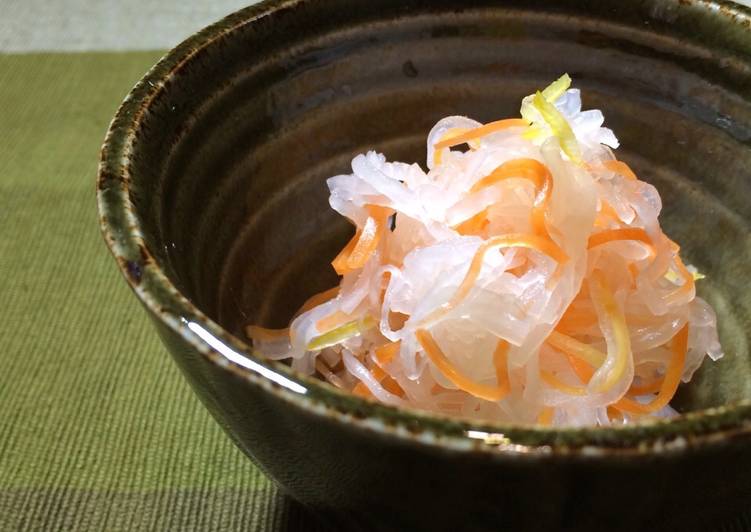Kouhaku Namasu (Daikon and carrot pickles). Kintoki ninjin/carrot However, an orange color carrot is usually used for this dish because it's more common in Japan. Kouhaku namasu is often called namasu and this pickle can be eaten anytime and not only on special days. Prepare the carrot similarly to the daikon radish.
 First lightly, then gradually increasing in pressure until they are soft and pliable.
Instructions Grate the daikon and carrot into a bowl.
Tightly squeeze the excess water out of the daikon and carrot with your hands then discard the water and return the daikon and carrot to the bowl. ❶ Slice daikon diagonally into very thin slices and julienne.
First lightly, then gradually increasing in pressure until they are soft and pliable.
Instructions Grate the daikon and carrot into a bowl.
Tightly squeeze the excess water out of the daikon and carrot with your hands then discard the water and return the daikon and carrot to the bowl. ❶ Slice daikon diagonally into very thin slices and julienne.
Hey everyone, hope you're having an amazing day today. Today, I'm gonna show you how to make a special dish, kouhaku namasu (daikon and carrot pickles). It is one of my favorites. This time, I am going to make it a little bit unique. This is gonna smell and look delicious.
Kouhaku Namasu (Daikon and carrot pickles) is one of the most popular of current trending meals on earth. It is simple, it is fast, it tastes yummy. It is appreciated by millions every day. They are fine and they look wonderful. Kouhaku Namasu (Daikon and carrot pickles) is something that I've loved my whole life.
Kintoki ninjin/carrot However, an orange color carrot is usually used for this dish because it's more common in Japan. Kouhaku namasu is often called namasu and this pickle can be eaten anytime and not only on special days. Prepare the carrot similarly to the daikon radish.
To begin with this particular recipe, we have to prepare a few ingredients. You can cook kouhaku namasu (daikon and carrot pickles) using 6 ingredients and 12 steps. Here is how you cook it.
The ingredients needed to make Kouhaku Namasu (Daikon and carrot pickles):
- {Get 600 g of daikon radish.
- {Get 60 g of carrot.
- {Prepare 9 g of salt.
- {Make ready 3 tablespoons of sugar.
- {Prepare 4 tablespoons of vinegar.
- {Prepare to taste of Yuzu skin.
Put daikon and carrot in a bowl, sprinkle salt, and mix. Namasu (なます) is daikon and carrot salad lightly pickled in sweetened vinegar. It's also called Kohaku (red and white) Namasu (紅白なます). Red and white are considered celebratory colors in Japan and these colors are often used in many traditional ceremonies.
Instructions to make Kouhaku Namasu (Daikon and carrot pickles):
- In a bowl, combine the sugar and vinegar. Set aside for later..
- Cut the daikon radish into 5 cm slices..
- Peel them..
- Place slices on end and slice thinly..
- Lay the slices on top of each other..
- Cut into thin julienne strips..
- Prepare the carrot similarly to the daikon radish..
- Place the daikon and carrot into another bowl. Add the salt and then massage the mixture with your hands. First lightly, then gradually increasing in pressure until they are soft and pliable..
- When the vegetables feel sufficiently pliable, gently squeeze out any excess moisture, but not so much as to make them dry..
- Mix the vegetables with the sweetened vinegar from earlier. If available, add a small amount of julienned yuzu skins to add fragrance to the pickles..
- Set it aside in the fridge for at least a day to soak. This is needed to pickle the vegetables. During this time, they will soften and develop a milder flavor..
- Note: •To ensure good color distribution, make sure the amount of carrots doesn't exceed 10% of the amount of daikon. •The amount of salt should make up around 2% of the vegetables in total..
Namasu is a type of salad made of raw (nama) vegetables and vinegar (su). The vegetables chosen for a namasu which make it a worthy addition to osechi ryouri are carrot, for its (almost) red vividness, and daikon (white radish) for its pure white colour. Namasu is a simple Japanese pickle that's ready in an hour. It can double as a refreshing tangy-sweet salad. Namasu (紅白なます) is a daikon and carrot salad lightly pickled in sweetened vinegar.
So that is going to wrap this up with this exceptional food kouhaku namasu (daikon and carrot pickles) recipe. Thanks so much for your time. I'm confident that you can make this at home. There is gonna be more interesting food in home recipes coming up. Don't forget to bookmark this page on your browser, and share it to your family, colleague and friends. Thank you for reading. Go on get cooking!